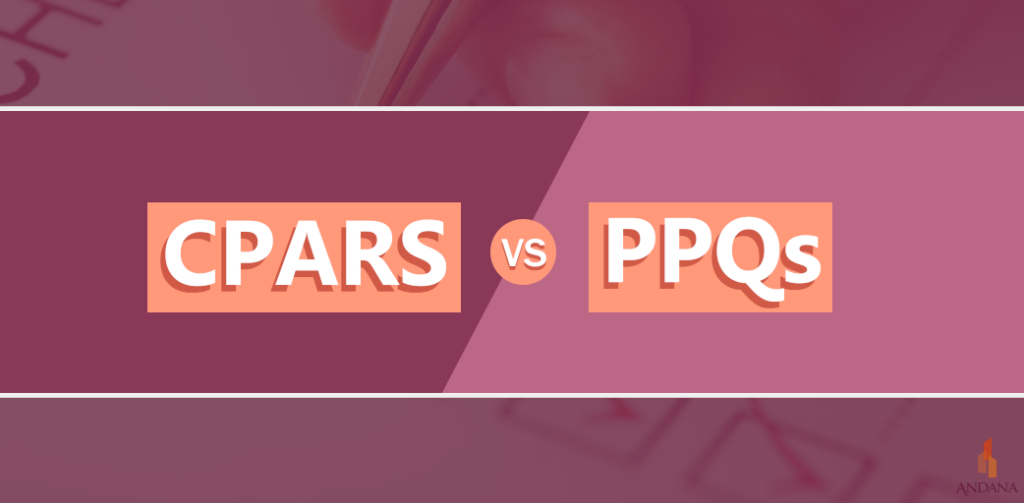
When writing proposals to the Federal government, past performance is one of the most important evaluation factors. Agencies use past performance ratings to understand how a firm delivered previous projects. These ratings cover quality of work, cost control, schedule control, overall management and sometimes other categories that were relevant to that project such as small business utilization or regulatory compliance.
As teams responding to proposals, we provide narratives about our experience, showcasing what we have accomplished and how it sets us up for success on the project we are pursuing.
Then, we provide our past performance ratings, in the form of CPARs or PPQs to further substantiate our expertise and maybe showcase a bit of what it is like to work with our team.
CPARS is the Contractor Performance Assessment Reporting System
PPQs are Past Performance Questionnaires
Both of these tools are used to demonstrate past performance when bidding to the Federal government. Below are some commonly asked questions about these tools and how to use them, and when to ask questions of the contracting officer.
- How do I get a CPARS rating? CPARS are only issued for Federal contracts. If you do not have a Federal agency as your client, you will not have a CPARS rating. If you are using a state, local, or commercial project for past performance, it will not have a CPARS rating. In which case, you’ll use a PPQ (see #3 below). If you have a Federal contract, your firm can access your CPARS ratings when they are issued. Typically CPARS are provided at an ‘interim’ phase, when the project is about half way complete and a ‘final’ phase, when the project is closed out. As industry, we do get an opportunity to provide comments on the CPARS ratings as they are issued. Make sure your firm works closely with the client contacts – you should be aware of what ratings you will receive before they are posted. Make sure, at the start of the contract, both your project team and your customers know what it will take to get a “very good” or “exceptional” rating.
- Is it OK to submit an Interim CPARS rating with my proposal? Typically, the answer is yes, but only if the proposal instructions/evaluation criteria allow for projects that are still ongoing. If the requirement is to provide a completed project, a Final CPARS is preferred… But we all know that sometimes a project is complete, but the paperwork still remains. In which case, we’d suggest providing the interim CPARS but contacting your point of contact on the project to let them know you are submitting it as Final so if the contracting officer calls to discuss, they are aware of the situation. We’d also suggest putting a note in your experience narrative, or on the cover sheet for the CPARS showing the project completion date and a note that final CPARS have not been issued.
- So why do we need a PPQ? If you are using non-Federal projects/contracts as past performance, your firm will not have a CPARS rating for those. In which case, the government still wants to see the client feedback on your deliverables. USACE and NAVFAC have a PPQ-0 form that they both use for this questionnaire (we’ve linked to a Word version of the form for you!). Other agencies often have their own version of the form.
- How does the PPQ form work? Your solicitation should contain instructions for how the agency wants to receive the PPQ forms. Often, they want you to send the form to your client and provide the completed form in the proposal. Sometimes they want you to send the form to your client and have the client return the form directly to the contracting officer. In some of those instances, they even provide a letter for you to send with the form so it has the pertinent contact information and deadlines. In either case, you want to get the forms out to your clients as soon as possible so they have adequate time to complete the form.
- My clients don’t have time to complete a form each time, can I reuse old forms? More and more, agencies are allowing firms to submit previously completed PPQ forms. Double check your solicitation for this guidance. If they do not provide guidance on using older forms, ask the question.
- We can’t get a form before the due date, what do we do? If you cannot get a PPQ form completed prior to submitting the proposal, for any number of reasons, most agencies allow for you to include the first page of the form in your response. The first page of the form has the contract information as well as the customer point of contact name, phone, and email. Including the first page allows the agency to reach out to your point of contact if needed.
- Do I need both CPARS and PPQ? Most often, if you have a CPARS for a project you do not submit a PPQ form. If your project is too new for a CPARS rating, then you should request a PPQ (also make sure you can use a project that is ongoing).
- Can’t the Government access CPARS, why do we need to include them? Yes, Federal agencies can access the CPARS system from their side using your firm’s information. Including the remarks in your proposal allows them to quickly reference the performance ratings side by side with your experience narrative. Federal agencies can also login to CPARS to see other ratings for projects not included in your proposal.
- Where do these forms go in my proposal? If you are submitting an SF330, the forms are usually attached as an appendix to SF330 Part I – Section H. If you are submitting a proposal, the forms are generally provided in their own tab in a past performance volume. Review the solicitation instructions (or SF330 synopsis) to find where the contracting officer wants them to be provided. Since the forms are sometimes long, we recommend putting a simple title page with the project name and maybe the contract number, before each evaluation form. It makes it easier to 1) ensure your forms are all there and in the correct order (same order that you show the projects in your experience section), and 2) ensure the evaluators can find them easily.
- What should I do with these forms after the proposal? Keep them for use in a future proposal. If you have a database, save them with the project information. If you use a file folder system on a server or shared drive, create a folder for CPARS and PPQs for easy reference in the future. Sometimes knowing you already have a strong PPQ form or CPARS in hand can help with selecting projects to showcase. Another #protip – if you know you will be using a project in a future proposal and know you will need a PPQ, use the PPQ-0 form and ask for it before you absolutely need it for a proposal.
